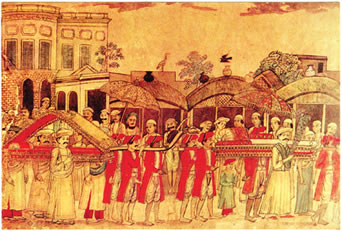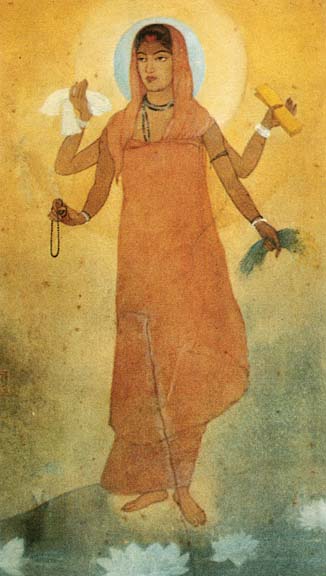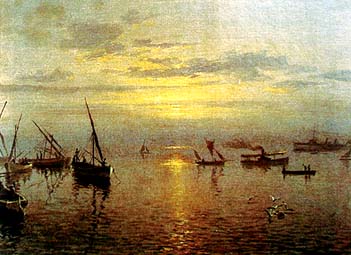Bengal Art
Bengal Art (Colonial Period, 1757-1947) Art in Bengal developed in varied and diverse ways during the nearly two hundred years of British colonial rule. This development was greatly influenced by the tastes and attitudes of the' ruling English, but various trends and styles can' be identified.
Foreign artists After the establishment of British rule a host of artists from England and other countries of Europe travelled to India in the hope of becoming rich overnight, of whom at least 60 names can be traced. These artists worked primarily in three techniques: a) oil on canvas, b) miniature paintings in water colour on ivory, and c) water colour on paper and prints made from them by engraving process. Prominent among the oil painters were Tilly Kettle, John Zoffany, Arther Davies, Thomas Hicky Francesco Ronaldi, Robert Home, William Beechy, Marshal Clakson, Vereschagin. Ozies Humphrey, George Chinnery and Sir Charles D'Oely were notable miniature painters on ivory. Notable engravers and printmakers were William Hodges, Balt Solvyns, James Mofat, Colsworthy Grant, William Simpson, and the uncle-nephew duo of Thomas and William Daniel. Apart from them, a number of untrained artists painted in their pastime or out of curiosity. Prominent among them were James b Frazer, William Princep, Emily Eden, Madam Belson, and G F Atkinson. Apart from John Zoffany and a few others, most of these artists were of moderate merit and fame. Though their art do not have much aesthetic significance, they, however, contributed greatly in preserving the life and nature of 18th and 19th century Bengal in a most vivid and naturalistic way and in a manner which has had profound historical significance.

Company art After the disintegration of the Mughal Empire in the early 18th century, artists of the Mughal court started to take refuge in provincial states like Ayodhya, Patna and Murshidabad. They continued to paint in their traditional style under the new patrons and their paintings were often termed as 'Provincial Mughal Art'. After the fall of Murshidabad and the rise of Calcutta (Kolkata) as the centre of colonial rule, artists from Murshidabad, and even from Ayodhya and Patna started to gather in Kolkata in search of job. Initially the Company employed English artists to do the architectural, botanical and zoological drawings necessary for their administrative purposes. But as they were more expensive, local artists were gradually trained and employed for these jobs. These provincial artists very quickly learned the new technique and by assimilating it with their traditional knowledge created what is now termed as 'Company Art'. Pir Bux, Shaikh Zainuddin and a few others excelled in this style. But the finest of them undoubtedly was Sheikh Muhammad Ameer, who was active around 1840-50. His paintings of animals could well be compared with any of the best European examples of the period.
Kalighat patachitra Another local trend of painting prevalent throughout the late 18th and the whole of the 19th century centred around Calcutta's Kalighat temple, and is now well known as Kalighat Patachitra. This style originated after colonial rule had destroyed the equilibrium of Bengal village life and after the village Patuas began losing their livelihood. As a result, Patuas from the vicinities of Calcutta, mainly from the nearby districts of 24 Paraganas, Hawrah and Medinipur, started to throng around Kalighat temple and started selling paintings of deities done on cheap paper in local watercolour to devotees and pilgrims. These low cost items gained immense popularity. Initially the Patuas painted traditional religious subjects, but the contact with urban life made them look for contemporary and secular subjects. The life of the English people and more interestingly, the depiction of the life of the Calcutta Babus, became more popular items. The Patuas reflected in their paintings the incoherence of the urban life with an extraordinary sense of humour. Kalighat Patachitras derived definite inspirations from folk dolls and statuettes. They have become famous for the beauty of their undulated flowing lines, their particular technique of achieving modulation, and their amazing sense of observation, simplification and proportion.
Western academic style Formal Art education in India started with the establishment of the Mechanical Institute in Calcutta in 1839, though proper art education began with the founding of the Calcutta School of Industrial Art in 1864, which later became Government School of Art. A host of Indian artists skilled in European art techniques subsequently pioneered a new generation of artists in India. annada prasad bagchi and Shaymacharan Srimani were among the most prominent in the earlier period. Another painter of the 19th century, Bamacharan Bannerjea, painted Indian mythical scenes in oil and had them printed from Germany well before the better-known Ravi Barma of Kerala. Rohinikanta Nag and Shashikumar Hesh were the first Indians to go to Italy to receive higher education in art. Hesh was acclaimed as an outstanding painter in England and Germany. Despite the rise of a revivalist style of art at the turn of the century and its widespread popularity, the western naturalistic style remained a major stream. Many celebrated artists worked in this style during the first half of the 20th century. Prominent among them were Jaminiprakash Gangooly, Prohlad Karmakar and Deviprasad Roychowdhury.

Abanindranath and Bengal school EB Havell, a connoisseur and promoter of Indian art, was appointed Principal of Calcutta Art School in 1896. In 1905 Havell persuaded Abanindranath Tagore to join the School as Vice-Principal and together they introduced traditional Indian techniques of art in the school. Nandalal Bose, Surendranath Kar, Asit Kaumar Halder, K Venkatappa, Samarendranath Gupta, Kshitindranath Majumder, Sailendranath Dey joined as disciples of Abanindranath and helped introduce a new revivalist style of painting. In the nationalistic fervour of the time it gained tremendous popularity and spread all over India. In fact, the 'Bengal School', as it was known, was the first recognized art style of modern India.
Havell and Abanindranath insisted on the revival of traditional Indian art styles. In fact, the revivalist art introduced by Abanindranath was actually a synthesis of Ajanta, Mughal, European naturalism, and Japanese wash techniques. This new art style, done mostly in watercolour and depicting Indian religious, mythological, historical and literary subjects, also gained the approval of the Indian nationalists. Abanindranath preferred historical and literary subjects rather than religious and mythical ones, and with his sophisticated taste, sense of proportion, and observation he could impart a quality of grace and charm to his works. But, excepting one or two, his disciples were less gifted. As a result, the Bengal School became a kind of a sentimental and decorative art and did not develop any further.
The creative individuals In the early decades of the 20th century, the Bengal School as a whole became popular, but some individual creative figures attempted to go beyond prevalent trends and tried to gain artistic independence and individuality. Gaganendranath Tagore, Jamini Roy and rabindranath tagore are among the best known of these artists. Gaganendranath, the elder bother of Abanindranath, was the first genuine cartoon artist in India to comment upon political and social realities. He was also the first to treat painting as an arrangement of line, form, color and light. He has done paintings of building and interiors by treating light and shade in a somewhat Cubist manner. His mythical and spiritual contemplation pieces, done in form and colour, sometimes reach the state of near-abstraction.

Though the merits of folk-art was not completely neglected at the time, nobody before Jamini Roy could think of applying it in the arena of mainstream art. By abandoning the naturalistic style and taking inspiration from Bengali folk art, he opened a new vista for modern Indian painting. He abandoned the three-dimensional modulation, that is to say, the stress on perspective and light and shade of naturalistic western art. Instead, he took to the two-dimensional format of flat colouring and undulated outline of the folk tradition. He created out of the folk mannerism a more sophisticated and harmonious form of painting which expressed a new kind of simple beauty while retaining a kind of Indianness.
Though Rabindranath Tagore started his sporadic attempts at painting in the 1920s, it was in the next decade that he appeared as a major painter in India. His poetry and prose display a continuation of Bengali and Indian traditions, but his paintings are original works of an individual who have a very high sense of imagination and fancy. They might also be related to his profound knowledge of contemporary western art. They show primitive power and unreleased energy.
Print art Art works printed in different techniques played an important role in the colonial period. The Daniels printed their 'Twelve Views of Calcutta' (1786-88) in India. The first Bengali engraver was Ramachandra Roy and his Annadamangal, printed in Calcutta in 1816, was the first Bengali book to have engraved illustrations. Though in the beginning, printing presses were owned by the English, native Bengalis started their own presses in the late 19th century and started printing books with illustrations engraved in wood or metal which were known as battalar boi (books of Battala). These cheap booklets depicted religious and mythological events, or contained popular stories and children's texts. They had immense influence on the general public. Artists who engraved the illustrations for the books came from generations of carpenters and metal-craftsmen; their works derived inspiration from kalighat paintings.
Another print technique, which also gained popularity, was Lithography. Introduction of the technique was made possible by the education imparted in the art schools. Annadaprasad Bagchi and his associates established 'Calcutta Art Studio' in 1876. The studio produced and sold litho prints of religious and mythological scenes, portraits and alphabets, which were popular items in middle class house-decoration. But the most successful artist in print art was the famous Kerala painter Raja Ravi Barma. In 1894 he established his own press and his prints in Oleograph became immensely popular all over India, including Bengal.
New trends The Second World War and the global economic recession of the late 30s and early 40s of the 20th century ushered a new kind of social awareness among artists, writers and people in other creative fields. Artists sought to come out of the strait-jacket of persistent mythological and historical depictions and endeavoured to reflect contemporary life in their art. In this attempt they established artists groups, such as 'Young Artists Union' and 'Art Rebel Centre' (1933). Prominent among them were Gobardhan Ash, Abani Sen, Annada Dey, Bhola Chatterje, Atul Bose, Gopal Ghosh etc. Mukul Dey and Ramendranath Chakrobarty were among the pioneering printmakers. Muralidharan Tali, Adinath Mukherjea, Safiuddin Ahmed and Haren Das were important exponents of print techniques. In the 1920s Rabindranath established 'Kalabhavan' in Shantiniketan. Under the leadership of Nandalal Bose, a new kind of art developed in Shantiniketan which was a free synthesis of east and west and which is most evident in the art of two vastly gifted pupils of Nandalal-Bennodebehari Mukherjea and Ramkinker Baij. The Second World War and the global economic recession of the 1940s threw the common people's life in utter devastation. Their suffering culminated in the Great Bengal famine of 1942-43, in which millions died of hunger. This calamity aroused the conscience of Bengali artists. Though many artists of repute came forward to depict the horror in their works, the dreadful reality in all its terrible aspects was most vividly portrayed by two young artists - zainul abedin, a teacher and founder principal of the Government Art Colleg, Dhakae and Chittaprasad, a Communist Party worker.
Meanwhile, during the two hundred years of colonial rule there was no activity in the field of fine arts in East Bengal. While in the same period Calcutta flourished to become the prime centre of politics and culture not only in Bengal but also in whole of India. There was no trace of any cultural activity in Dhaka or any other city of present day Bangladesh. Dhaka remained a small suburban city and any enterprising Bengali, irrespective of caste or religion, moved to Calcutta for his advancement. As a result, though folk art and culture remained rich and colourful, no tradition of mainstream art activity evolved in this region during the colonial period. However, many European artists travelled to parts of East Bengal and painted scenes of Dhaka, Chittagong and other parts of the land. While well-known painters like George Chinnery and Sir Charles D'Oely painted scenes of Dhaka, most of them were par-time painters having only a modicum of talent.
The bangladesh national museum is fortunate to have 39 examples of watercolour paintings of Eid and Muharam festivals of Dhaka done in the early 19th century by an artist named alam musawwir. The artist seems to be a descendant of the Murshidabad guild of the provincial Mughal School. It seems likely that a feeble flow of Company painting style might have reached Dhaka in the late 18th century. However, one cannot be sure about this point because of the non-availability of any other evidence. Usually, aspirants to art from East Bengal used to go to Calcutta for training and stayed there for livelihood. It was only after the partition, 1947 that Bengali Muslim artists migrated to what became East Pakistan and started a systematic art movement in this area. [Abul Mansur]
Bibliography M Archer and WG Archer, Indian Paintings for the British 1770-1880, Oxford, 1955; J Appasamy, Abanindranath Tagore and the Arts of His Times, New Delhi, 1968; W G Archer, Kalighat Paintings, London, 1971; Atul Basu, Banglay Chitrakala O Rajnitir Eksha Bachhar, (in Bangla), Kolkata, 1993; P Mitter, Art and Nationalism in Colonial India, 1850-1922, Cambridge, 1994.
